What to Do if You Have Neck Pain on the Right Side
Updated: Jun. 11, 2021
A holistic approach to this type of neck pain is your best bet for easing aches. Try these expert-approved moves to find relief.
Dealing with neck pain on one side
Here’s the thing about nagging aches and pains: unless you can track their source to a specific event, like a car accident or sports injury, they can be a little tricky to figure out.
Sudden aches and pains—say, your back “going out”—are often a result of chronic muscle imbalances, postural issues, or a general lack of strength or mobility stemming from a sedentary lifestyle.
That’s why if you’re experiencing neck pain on the right side, left side, or both, you may have to tackle the problem holistically (and with help from a doctor or physical therapist) to make sure you’re addressing the root cause.
Reasons for neck pain on one side
Generally speaking, if you’re experiencing neck pain only on one side, it’s probably not a cause for excessive concern. With the right prescription of stretching, strengthening, and tension-reducing techniques, you’ll likely feel better in a matter of days or weeks.
Simple causes, like sleeping “wrong,” chronic poor posture (particularly if you tend to tilt your head to one side or the other), or repetitive movements (like constantly looking to the left to check your blind spots while driving), can all play a role.
Likewise, sudden injuries or accidents that cause whiplash may lead to neck pain on the right side, particularly if you were looking to the side when the injury took place.
When to get help for neck pain
While self-treatment at home can often relieve mild to moderate neck pain, it’s important to know when to call an expert.
If the pain is sharp, interferes with your daily activities, or causes radiating pain down the arms, you should get in contact with your doctor.
Another reason to give your doctor’s office a ring—the onset of pain is sudden and severe (with or without a known cause) and is accompanied by changes in consciousness or loss of function.
Neck and spinal pain isn’t something to be trifled with so, as a general rule, if you’re worried about the pain, see a doctor or physical therapist.
(Try these home remedies for neck pain.)
Strengthen, stretch, and release tension for best results
When it comes to addressing neck pain, even if it’s only occurring on one side, you need to plan a holistic approach to healing that addresses both sides of the body.
If the root cause is due to a muscle imbalance, stretching and strengthening both sides of the neck as well as surrounding musculature will likely lead to long-term relief.
“When treating a specific area of pain or discomfort, one of the biggest mistakes someone can make is neglecting to look at the painful area as a part of the body as a whole,” says Jake Harcoff, the head coach and owner of AIM Athletic in Langley, British Columbia, Canada.
Fact is, the neck bone is connected to the backbone—and so on.
“The body is a system based on biotensegrity, which means every tissue in the body is connected to a certain extent by a network of fascia,” he says. Fascia is a sheet of connective tissue that keeps organs, muscles, nerve fibers, bones, and blood vessels in place.
The body is a complicated system, but Harcoff explains that it’s like a spiderweb—pulling on one strand can effectively cause changes to far-reaching strands you wouldn’t have imagined are connected.
“In the case of one-sided neck pain, providing treatment upstream and downstream from the source, or to the opposite side of the body, can potentially provide relief and increased ability to effectively treat the injured area with effective movement practices,” he says.
Foam rolling, a therapeutic tool
Foam rolling can be a useful tool for recovery.
If you’re not already familiar with the benefits of self-myofascial release, it’s time to get acquainted with a foam roller.
Foam rolling before performing stretching and strengthening exercises can help release muscle knots (known as myofascial adhesions), thereby reducing pain, increasing blood flow, and enhancing flexibility before doing other therapeutic exercises.
“Perhaps the best thing that foam rolling does for the muscles is to free them to do their jobs,” says Joy Puleo, the education program manager and Pilates expert for Balanced Body Pilates company.
“Muscles are surrounded, supported, and invested by connective tissue called fascia,” he says. “When this tissue loses its elasticity or becomes rigid or tight, the muscles within this tissue are affected, restricting blood flow and circulation.”
Foam rolling can help reduce these adhesions and increase circulation, helping hydrate and nourish the muscles that have been experiencing limitations.
Ultimately, foam rolling can enhance your other efforts to relieve and prevent neck pain.
Foam roll: Mid to upper back
Foam rolling your mid to upper back is a great warm-up to help increase blood flow through your spine, back, and shoulders.
While you aren’t directly applying pressure to your neck during this exercise, the spine works as a cohesive unit, and foam-rolling the upper back may help you identify other areas of muscle adhesions and imbalances that may be contributing to your neck pain.
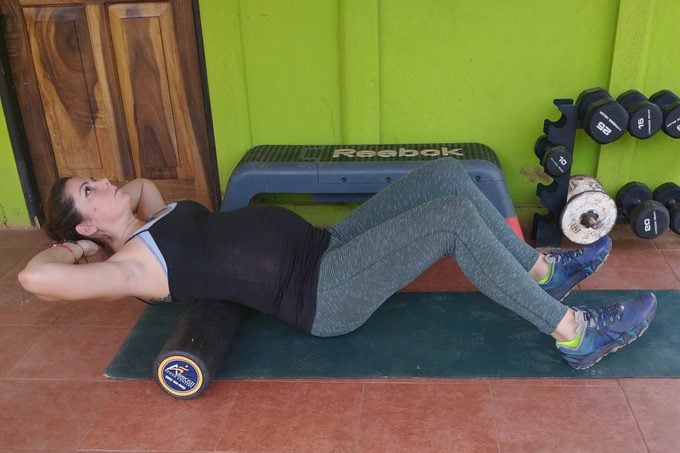
How to do it
Sit on a mat with a foam roller behind you. Lie back against the foam roller so that it rests horizontally across your mid back. Position your feet flat on the ground, roughly hip-distance apart. Bend your knees.
Engage your core and lift your hips from the mat so your body is supported by your feet and your back (on the foam roller).
Press through your heels and bend and extend your knees to roll your back up and down the foam roller between your mid back and your shoulders.
This rolling action should be slow and steady and should feel like a nice massage of your mid to upper back.
Take your time, and if you find a particularly sore spot, stop and allow gravity to help release tension in the area.
After several passes, lean slightly to one side and then the other as you roll, looking for tight spots on either side of the spine.
Continue rolling for 60 seconds.
(Try these chest exercises you can do at home.)
Foam roll: Neck
Foam-rolling the neck, particularly if you believe your neck pain is muscle-related, is an excellent way to experience a self-massage.
That said, if placing direct pressure on your neck causes pain, discontinue the exercise.
You may want to try a soft foam roller—rather than a high-density foam roller—to help prevent placing excessive pressure on your neck.
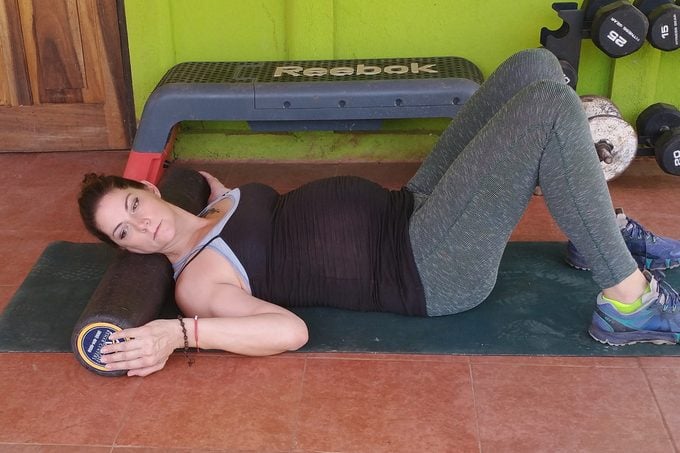
How to do it
Lie on your back on a mat with your knees bent, your feet flat, and your neck resting on a foam roller as though it were a pillow.
You may want to hold the ends of the foam roller with each hand to keep it steady and secure.
From here, slowly and steadily turn your neck to one side, then the other, seeking out any tight spots.
If you find a knot, stop and hold the position, breathing deeply as you relax the muscle into the foam roller.
If you have more neck pain on the right side than the left, spend more time massaging the tight areas on the right side.
Continue this side-to-side neck rotation for up to 60 seconds.
(Chest stretches can help improve your posture.)
Foam roll: Snow angels
If your neck pain is linked to rounded shoulders, poor posture, or limited mobility in your upper back or shoulders, foam roll snow angels may help.
This active stretch opens up the chest while taking your shoulders through a sweeping motion.
The key is to listen to your body. If you get to a point where your arms are unable to continue performing a full snow angel, stop and relax the movement for a beat before reversing the action.
The goal is to slowly enhance and improve your personal range of motion.
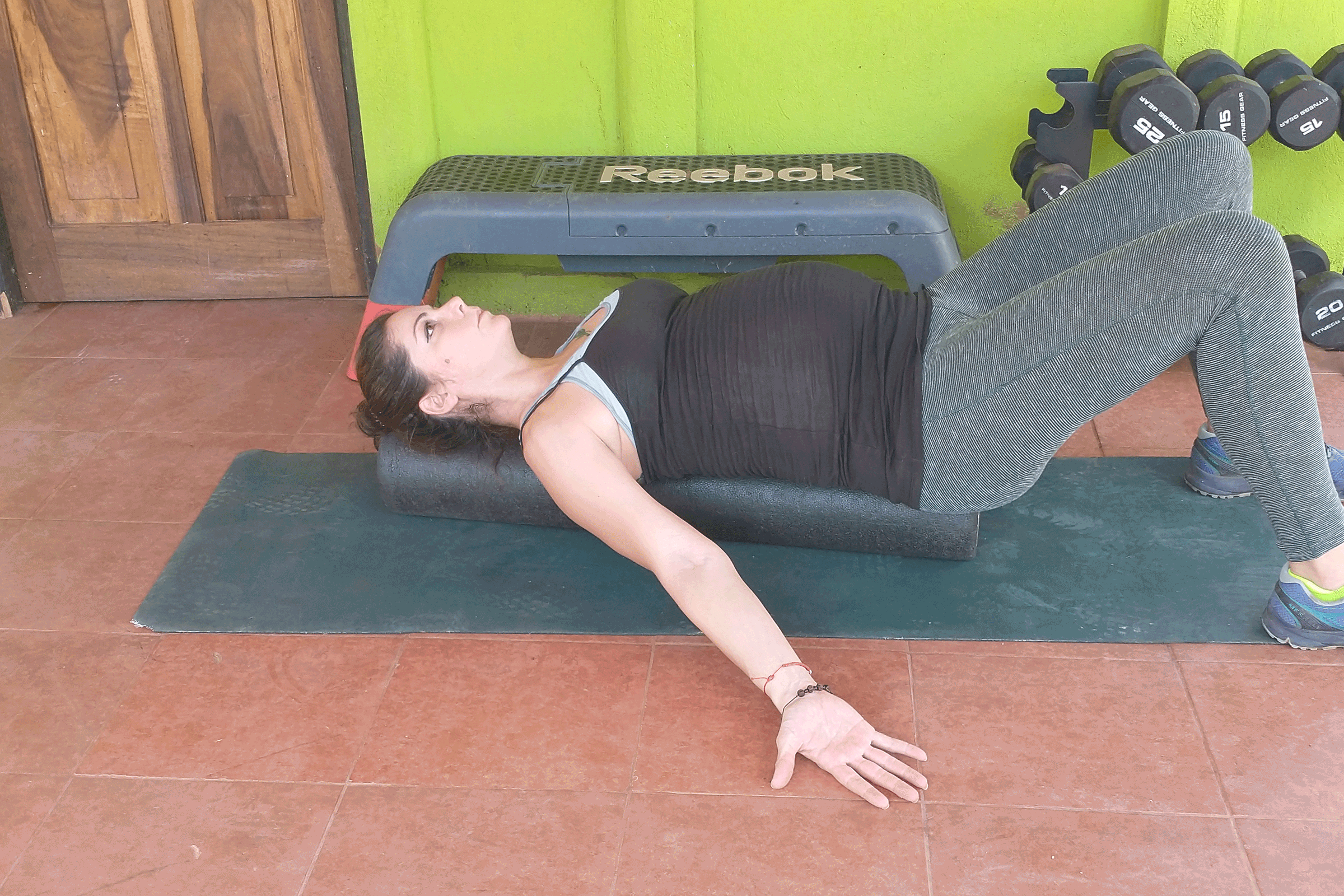
How to do it
Sit on the end of a long foam roller, your knees bent and feet planted, so the length of the foam roller is aligned with your spine.
Carefully lie back onto the foam roller so your spine is fully supported from your tailbone to your skull.
Allow your hands to rest on the floor outside your hips, your palms facing up.
If your chest is especially tight, you may already feel a stretch across the front of your shoulders. Slowly and steadily sweep your arms out and up, reaching them over your head as high as you comfortably can.
If you find a spot that’s tight, stop and relax, allowing your chest, shoulders, and arms to release any tightness. If you can’t physically continue the full range of motion, simply reverse the movement and return to the start.
If you can sweep your arms overhead, reverse the movement, turning your palms downward as you sweep your arms back to your sides.
Continue this snow angel action for 60 seconds.
If you find mobility issues more on the right side than the left, go ahead and try a single-arm snow angel for an additional 30 seconds, working on the spots that feel tight and limited. Just don’t push past your personal range of motion.
Scapular retraction
Neck pain is often related to poor posture that occurs due to modern life. Even pain that’s isolated to the right side may be traced to general bad habits like sitting with rounded shoulders or constantly looking down at your phone.
You may not even realize it, but sitting with one leg constantly crossed over the other can cause a chain reaction that results in pain on one side, particularly if you sit slumped when doing it.
This basic scapular retraction exercise can help strengthen your upper back and shoulders, resetting your posture as you stretch the front of your shoulders and chest.
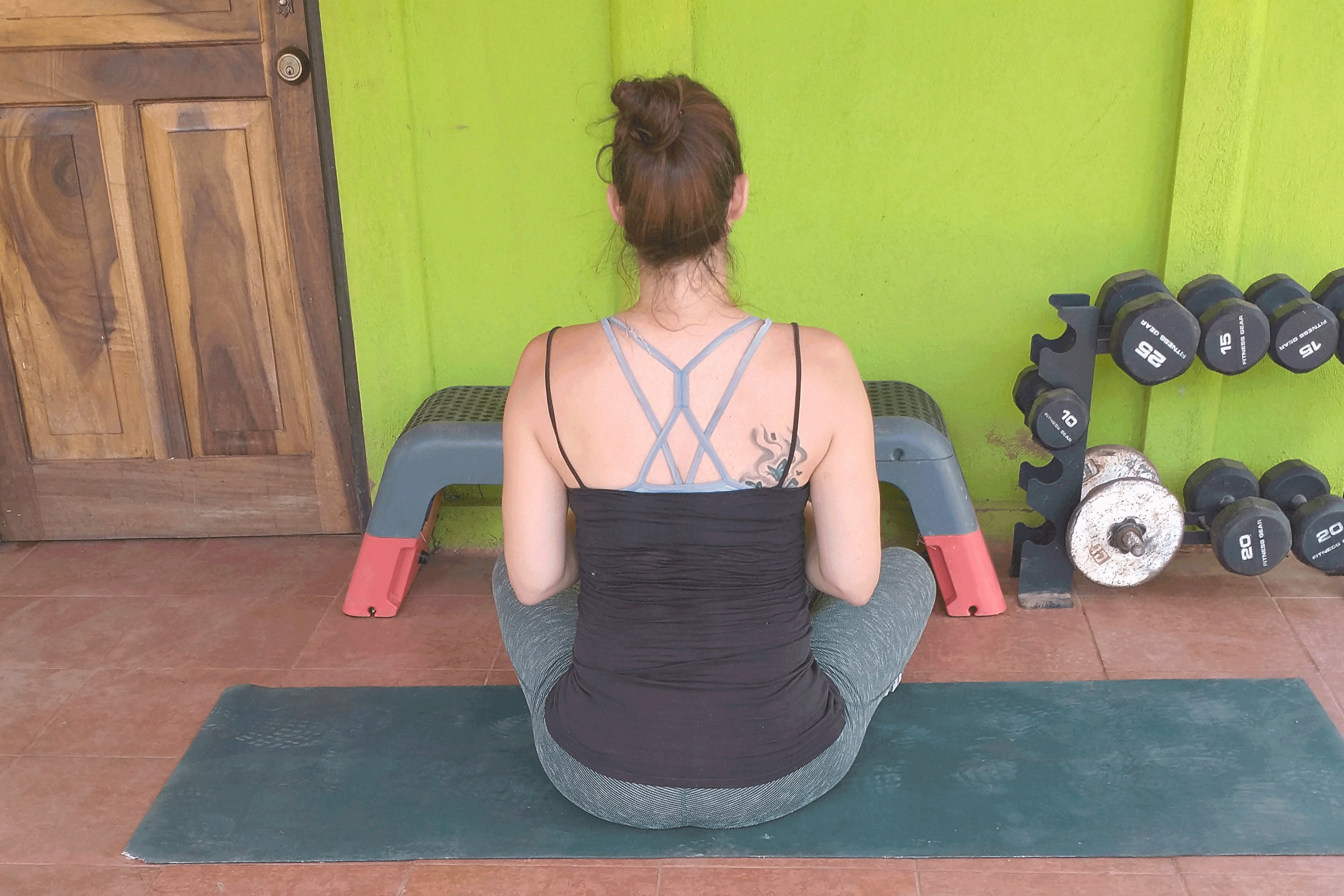
How to do it
Sit tall, your weight evenly distributed between your hips. Engage your core and check your posture. Your ears should be aligned above your shoulders and hips.
Try to create distance between your ears and shoulders by engaging your scapulae (shoulder blades), pulling them down and inward.
With your elbows bent, squeeze both shoulder blades back and inward, as though trying to touch them together at your spine.
Hold for a beat, then release. Repeat two sets of 20 retractions.
(Ease your neck pain with the levator scapulae stretch.)
Lateral flexion neck stretch
When you’ve completed exercises that target both sides of the body to help release tension, stretch, and strengthen, it might be time to try one-sided neck stretches to address specific pain points.
Since you’ve already had the opportunity to touch on areas of tightness with the snow angels and neck rolls, a good place to start is with lateral neck flexion.
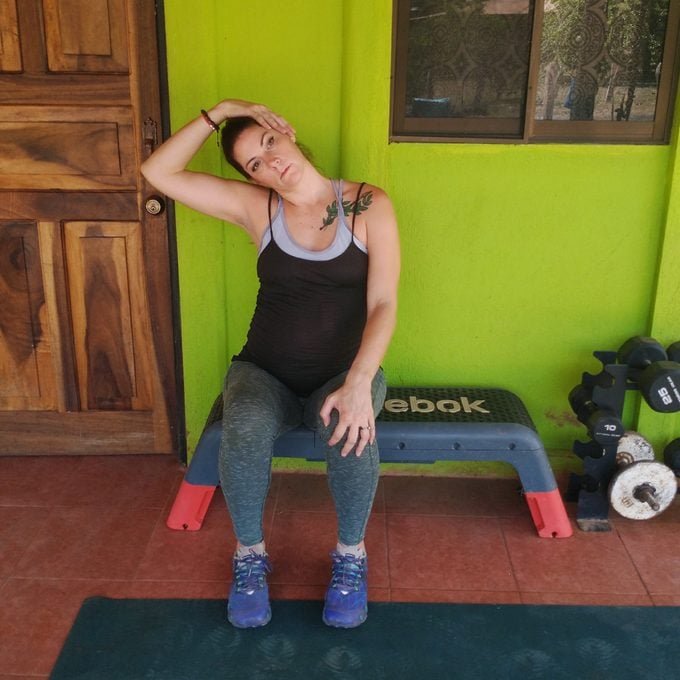
How to do it
Sit tall with good posture, your weight evenly distributed between your hips.
Check to make sure your shoulders are back, scapulae engaged, with your ears stacked above your shoulders and hips.
Without moving your shoulder, lean your head to the left as though trying to touch your ear to your shoulder.
Place your left hand on your right ear to hold the stretch in place. You should feel tension but not pain.
Hold for 20 seconds, release, then repeat two more times before switching sides.
Next, try these stretches for upper back pain.


















